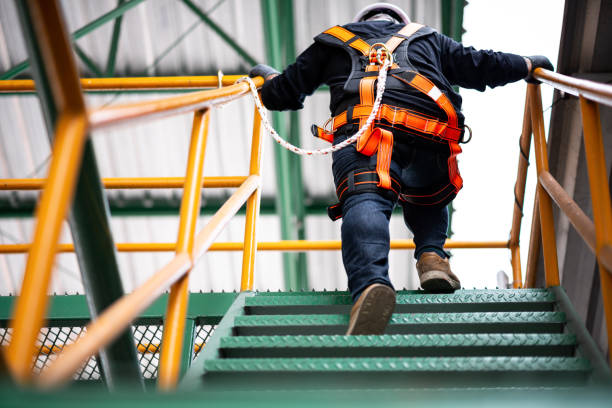Top-Quality Safety Railings and Guardrail Systems in the US 2025
Did you know modern safety railings can secure rooftops without piercing the roof, maintaining integrity while complying with OSHA? Discover how these modular, durable guardrails offer practical, eco-friendly protection you can install easily to keep your workspace safe and compliant.

Considerations for Choosing Safety Railings and Guardrail Systems
Safety railings and guardrails are intended to reduce falls from heights and improve worker safety in elevated environments. Contemporary fall protection guardrails blend safety features with ease of installation and adaptability to different roof types and configurations, offering:
- OSHA Compliance — Designed to meet regulations such as OSHA 29 CFR 1926.502 and 1910.29, supporting workplace safety requirements.
- Non-Penetrating Installation Methods — Many available systems use counterweights to avoid piercing roof membranes, which helps maintain roofing surface integrity.
- Modular and Customizable Configurations — Components assemble on-site without the need for welding or significant modifications.
- Durable Material Choices — Use of galvanized steel and aluminum resistant to corrosion and weather exposure.
- Environmentally Considered Elements — Incorporation of recycled PVC counterweights in some systems.
- Suitable for Various Roof Types — Systems designed to accommodate flat roofs, slight slopes, and different roofing materials.
How Modern Guardrail Systems Protect Workers and Roofs
OSHA Compliance Without Roof Penetration
OSHA standards (29 CFR 1926.502) specify criteria for fall protection on construction sites and general industry workplaces. Some guardrail systems in 2025 comply with these standards while allowing installation without roof membrane penetration. This method helps avoid potential damage to roofing materials and reduces the risk of leaks.
Non-penetrating guardrail systems stabilize structures using counterweights positioned on rooftops or raised surfaces. This approach supports fall prevention without compromising roofing integrity.
Modular Systems Provide Flexibility
Many guardrail products utilize modular components—uprights, base plates, elbows, and rail unions—that fit together onsite without welding, bending, or drilling. This design enables:
- Installation using common hand tools such as torque or Allen wrenches.
- Adaptation around rooftop features like vents and drains.
- Reconfiguration or relocation as roof layouts change or equipment is adjusted.
For example, certain systems like Kee Guard offer modular construction that can be tailored to fit various rooftop geometries while minimizing installation disruption.
Compatibility With Different Roof Types and Slopes
Contemporary guardrail systems accommodate various roof surfaces including:
- Flat roofs up to 5 degrees slope.
- Membranes such as bitumen, PVC, rubber, and TPO.
- Metal roofs, including trapezoidal and standing seam profiles.
Some guardrail variants are specifically designed for secure installation on standing seam and trapezoidal metal roofs, aiming to avoid compromising waterproofing.
Materials Used for Durability and Environmental Considerations
Corrosion-Resistant Components
Galvanized steel and aluminum are commonly used materials for safety railings to resist corrosion from weather exposure. These materials provide long-term structural strength with minimal upkeep.
Use of Recycled Materials for Counterweights
Certain systems employ heavy-duty counterweights made from recycled PVC. This practice contributes to stabilizing guardrails without penetrating roofs and incorporates an environmental aspect by reusing plastic materials.
Installation and Maintenance Information
Installation Process
Modern guardrail systems are designed to be installed with minimal specialist skills and simple tools. Installation typically involves a small team using hand tools like Allen or torque wrenches. This supports:
- Cost-effective setup by either in-house facility teams or external contractors.
- Deployment over various roof projects, potentially installing extensive lengths within a day.
- Availability of professional support such as installation guides, planning tools, remote assistance, and training.
Maintenance and Longevity
Durable materials and corrosion resistance enable guardrails to provide fall protection over extended periods, often 20 years or more. Routine inspections focused on checking fasteners and system integrity help maintain safety compliance.
Safety Coverage for Common Rooftop Hazards
Guardrails are intended to reduce risks around:
- Roof perimeters and parapet edges.
- Ladder access points.
- Roof hatches and skylights.
- Elevated equipment platforms or level transitions.
Implementing guardrail systems in these areas supports compliance with OSHA fall protection requirements and promotes worker safety.
Compliance with OSHA and Relevant Standards
Some guardrail systems comply with US OSHA standards for both general industry (29 CFR 1910.29) and construction (29 CFR 1926.502), as well as applicable international standards such as EN 13374 and EN ISO 14122. These certifications indicate adherence to established safety criteria for guardrail performance.
Support and Resources Available From Providers
Manufacturers and suppliers commonly provide resources such as:
- Product datasheets and BIM objects for integration in architectural and engineering designs.
- Guidance on guardrail system selection and installation.
- Customer service to assist with product inquiries or project planning.
These support tools can aid in making informed choices and streamlining implementation.
Summary
In 2025, safety railings and guardrail systems that comply with OSHA standards provide an approach to reduce fall hazards on rooftops and other elevated workspaces. Features of modern guardrails include:
- Designs that comply with regulations and avoid penetrating roof materials.
- Compatibility with multiple roof types and slopes.
- Use of corrosion-resistant metals and environmentally considerate counterweights.
- Installation processes that require standard tools and modest labor.
- Long-term durability and straightforward maintenance.
Products such as Kee Guard and similar modular systems offer configurable solutions supported by expert assistance to help enhance workplace safety while respecting structural and environmental requirements.
Sources
- CAI Safety - Guardrail Fall Prevention Systems
- Fall Protection XS - Safety Railing Fall Protection Guardrails
- Simplified Safety - Permanent Rooftop Guardrail
Disclaimer: All content, including text, graphics, images and information, contained on or available through this web site is for general information purposes only. The information and materials contained in these pages and the terms, conditions and descriptions that appear, are subject to change without notice.




